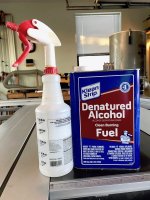For some reason raising/lowering the blade on this table saw is difficult. To lube, I raise the blade to its maximum height and then blow away all the sawdust from both shafts with my air compressor. Once this is done I lube the height spindle, lower and raise and lube again. Ditto for the tilting spindle.
The blade goes down easy enough, but raising it is somewhat difficult. The mechanism also squeaks when the blade is raised. The operation of the saw is perfect, so there are no problems whatsoever. I think that the blade should not be this difficult to raise. It seems as though I am compressing something when the blade is raised. The saw was put into service in May 2017 so it is not that old. That said, I do not recall how much muscle was required to raise the blade when it was new. I think it was probably much easier than it is now.
Both spindles are clean of any debris or buildup of any sort. So I'm thinking that something else needs to be lubed to elimate the squeaking and reduce the friction when the blade is raised.
Any comments or suggestions are most welcome.
(Off topic: I am not receiving forum notifications, but check in frequently. A moderator is trying to resolve this issue for me.)
The blade goes down easy enough, but raising it is somewhat difficult. The mechanism also squeaks when the blade is raised. The operation of the saw is perfect, so there are no problems whatsoever. I think that the blade should not be this difficult to raise. It seems as though I am compressing something when the blade is raised. The saw was put into service in May 2017 so it is not that old. That said, I do not recall how much muscle was required to raise the blade when it was new. I think it was probably much easier than it is now.
Both spindles are clean of any debris or buildup of any sort. So I'm thinking that something else needs to be lubed to elimate the squeaking and reduce the friction when the blade is raised.
Any comments or suggestions are most welcome.
(Off topic: I am not receiving forum notifications, but check in frequently. A moderator is trying to resolve this issue for me.)

